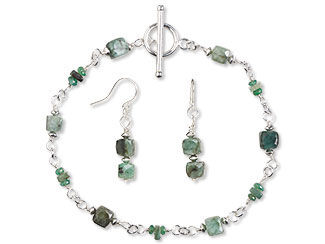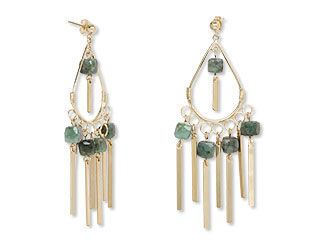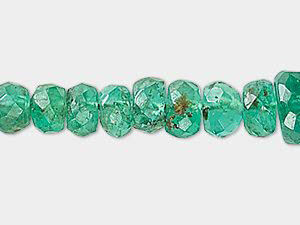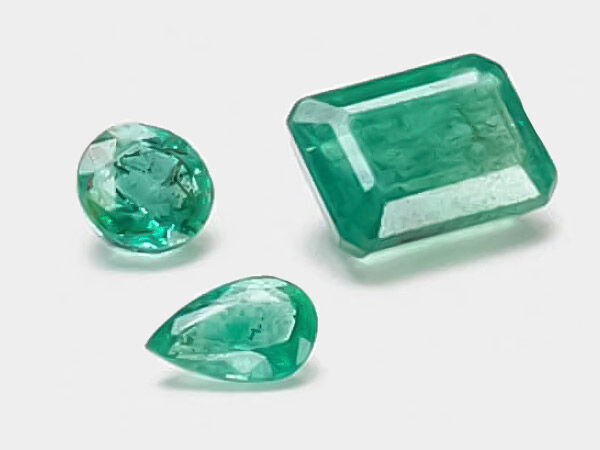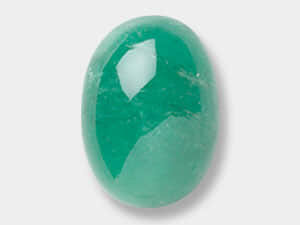Emerald Meaning and Properties
Emerald History
The name emerald comes from the Sanskrit word “marakata," which means spring green. Many legends and stories surround this magnificent and powerful stone. The Chaldeans, a kingdom of Biblical times, believed emeralds contained Ishtar, their goddess of love and war. In the Middle East, an emerald amulet would often be engraved with a verse from sacred religious texts.
Ancient Egyptians believed the green color of emerald represented fertility and rebirth. They would commonly carve emerald scarabs and place them at the heart of a mummy to make the deceased's health flourish in the afterlife. Cleopatra herself was known for her fascination with emeralds. Pale green emeralds were once thought by the Romans to be unripe and as they changed to a darker shade of green, they were maturing in potency. Gazing into the cool green color was reported by Pliny, an author and philosopher of ancient Rome, to ease eyestrain. The Roman emperor Nero Augustus reportedly watched gladiator games through a large emerald gemstone because he found the color to be calming.
In some legends, the Holy Grail used by Christ at the last supper was made from a giant emerald. Later, the emerald grail was used to collect his blood dripping from the cross, imbuing the grail with fantastic and holy powers.
Emerald is the traditional birthstone for May, but is also associated with the Cancer zodiac sign. Mystical or Tibetan birthstone charts place emerald as the January stone, Polish and Russian birthstones say emerald is the May stone while according to ancient Hebrew birthstones, the emerald belongs to June. Aside from birthstones, emerald is the 20th and 35th wedding anniversary gift.
As May's birthstone, learn why emeralds are one of the most fascinating and cherished gemstones in the world and how to set your own emerald ring.

What are the Metaphysical Properties of Emerald?
This mesmerizing stone's velvety green color is unmistakable. The rich color is renowned as a color of spring and has long been a symbol of romance, hope and rebirth. As the precious gem associated with the goddess Venus, emerald is also commonly believed to aid in fertility.
Throughout history, emerald's meaning has often been associated with various goddesses of love and beauty, such as Aphrodite and Ishtar. Emeralds were commonly believed to protect lovers from unfaithfulness. If the heart remained loyal, the gem would glow a beautiful green color, but it was thought that if a lover's heart went astray, the green color would lose its luster and rich color.
There were times in medieval history when emeralds were given to spouses because wearing an emerald was believed to enable the wearer to control their passion and lust. In addition, it was believed that wearing an emerald would improve memory and increase intuitive intelligence, enabling you to think clearly about the past, present and future.
Emeralds are believed to be encouraging, calming and balancing because of their color. They are also thought to promote creativity and restore optimistic hope in dreams and visions. They are thought to bring good fortune and are often seen in the cash boxes of business owners who seek to prosper in their endeavors.
What Chakra is Emerald?
Emerald’s meaning is strongly associated with the heart chakra, promoting love, compassion and emotional equilibrium. In these traditions, chakras are believed to be spinning energy centers within the body that influence emotional, physical and spiritual well-being. Each chakra corresponds to a specific area and color—emerald’s rich green resonates with the heart chakra, thought to aid in releasing negative emotions and promoting a sense of balance and unity.
Heart Chakra (Anahata) - Green
- Location: center of the chest
- Represents: the union of male and female principles; ability to love
- Emotional issues: compassion; trust; forgiveness; compassion; complex emotions; tenderness; equilibrium; love
- Spiritual issues: devotion
- Physical issues: immune system; cardiovascular system; lungs
- Gemstones: amazonite; aventurine; jade; malachite; peridot; rhodonite; rhodochrosite; rose quartz
Wearing chakra bracelets featuring emerald can support forgiveness, self-worth and emotional connection. To dive deeper into gemstone and chakra connections, check out this guide: Chakras and Their Gemstones.
What is Emerald Made From?
Emerald gemstones are a variety of beryl, which is the same mineral grouping as aquamarine. Genuine emeralds may contain inclusions—referred to as "jardin," a French word that means garden—which can cloud the stone. These inclusions are not considered flaws and indicate an emerald is genuine, not created in a lab.
It is common to coat emeralds with clear oil, paraffin wax or clear resin to diminish the appearance of surface inclusions and deepen the green color. Emeralds range in color from light to dark green. The shade of green is determined by the presence of chromium oxide and vanadium.
Emeralds can be found all over the world, including countries in South America, Africa, the Middle East and Russia.
- Mineral Information: Silicate, beryl group
- Chemical Composition: Al2Be2(Si6O18)
- Color: Emerald green
- Hardness: 7-1/2 to 8 (Mohs)
- Specific Gravity: 2.67 - 2.78
- Refractive Index: 1.576 - 1.582
How Do You Clean Emerald?
Emeralds should be spared from rugged wear. The best way to clean emerald jewelry is with warm water and a soft brush, patting dry with a soft cloth. Protect emeralds from scratching and sharp blows that can fracture or shatter the stone. Avoid large temperature changes, ultrasonic cleaners and steam cleaners that can damage or remove the oil/wax/resin coating that protects the stone.
Emerald - FAQ
Q: Where are the largest and most famous emerald deposits located in the world?
A: The South American country Colombia is the world's leading producer of emeralds, with the nation’s Muzo and Chivor mines being the most renowed.
Q: What are some of the most famous emeralds in history or culture?
A: The Gachala (Columbian, now in the USA); the Mogul Mughal (Columbian, now in Qatar); the Mim (Columbian, now in Lebanon); and the Duke of Devonshire (Columbian, now in the UK)
Q: Do emeralds have inclusions?
A: Yes, inclusions are considered a defining characteristic of natural emeralds. Often referred to as Jardin (“garden”) because they resemble plant life, emerald inclusions can be fluids, crystals of other minerals or internal fractures.
Q: How do you store emerald jewelry?
A: Emeralds are the Greta Garbo of gemstones and want to be stored alone, separate from other pieces, in a velvet-lined jewelry box or soft cloth pouch.
Q: What is the best way to use emeralds in jewelry design?
A: Emerald has some classic partners—yellow gold, diamond, ruby and sapphire—but also looks timelessly elegant with cultured freshwater pearl, jet, rhodolite garnet, white topaz and amber. Considering emerald’s structure and vulnerability to impacts, this gemstone is best used for earrings and necklaces which will not receive impacts.
Q: Will emeralds fade over time?
A: Emeralds are generally colorfast, with their hues stable in sunlight, mild heat and UV exposure. However, they must not be exposed to extreme heat or harsh chemicals such as chlorine.
Designing with Emerald
Precious emerald gemstone beads mix well with other brightly colored gemstone beads such as sapphires and ruby pink Malaysia jade, vividly dyed agate and brightly colored onyx gemstone beads. Elegant styles made with silver metals create a cooling effect, while designs fashioned with gold-filled and "vermeil" evoke an ancient royal essence. Pair emeralds with other green gemstones, crystal beads and lustrous cultured freshwater pearl beads for statement jewelry designs.
A Couple Design Inspirations to Get You Started
Shop for Emerald
**Please note that all metaphysical or healing properties listed are collected from various sources. This information is offered as a service and not meant to treat medical conditions. Fire Mountain Gems and Beads® does not guarantee the validity of any of these statements.
How did you like this resource? Your feedback helps us provide resources that matter to you most.
Copyright Permissions
All works of authorship (articles, videos, tutorials and other creative works) are from the Fire Mountain Gems and Beads® Collection, and permission to copy is granted for non-commercial educational purposes only. All other reproduction requires written permission. For more information, please email copyrightpermission@firemtn.com.

